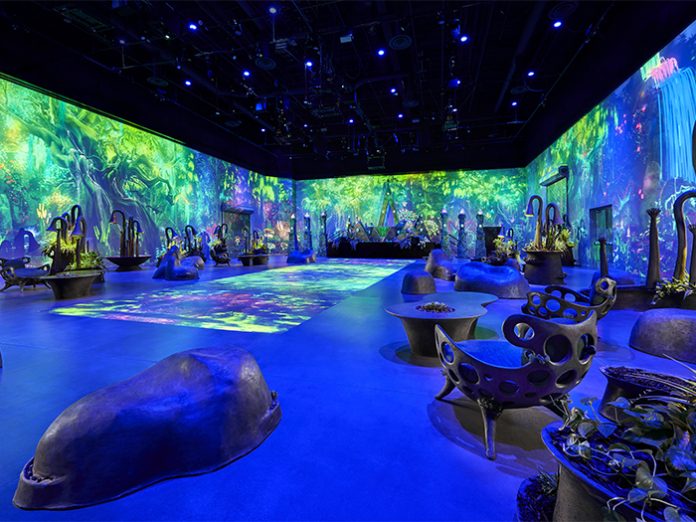At AREA15, the new art and entertainment district located minutes from the Las Vegas Strip, visitors should expect the unexpected. Behind the looming exterior façade, the vast, 200,000 square foot interior houses a collection of themed retail and entertainment options, all surrounded by an air of cosmic mystery. One principal attraction is a space called “The Portal” where, behind imposing metal doors, visitors can plunge into a 360-degree projection-mapped video experience supported by immersive audio enabled by Meyer Sound’s new Spacemap Go spatial sound design and live mixing tool.
The 6,584 square foot Portal was initially conceived primarily as a large meeting and event space, one that could compete with the posh hotel ballrooms on the Las Vegas Strip while offering its own unique ambience. To that end, the projection systems were designed for four-wall coverage allowing surround video for either the entire space, or for one or two walls when the room was subdivided into smaller spaces.
The opening of AREA15 was delayed by the pandemic, and when the public finally was admitted the total numbers had to be limited to about 25% capacity. That put most meetings and party events out of the picture. Fortunately, with a boost from Spacemap Go, the Portal was transformed into an immersive experience where visitors could stay distanced in the spacious room.
“When Steve Ellison of Meyer Sound first introduced me to Spacemap Go, I didn’t quite get it,” admits David Johngrass, production manager at AREA15. “I figured I could do much the same thing with our digital console. But he pointed out that I would have to do things like bounce out a new track, and then drop it back into the show file. But with Spacemap Go I could do it on the fly, in real time, and here in the space so I know exactly the effect I’m getting. That’s when it clicked. This is huge, I thought.”
Some basic spatial sound trajectories were incorporated into the first experience in The Portal, Gallerie 360, a 30-minute sound and light exhibition by digital artists Darpan and Max Cooper. “We’ve just scratched the surface with Spacemap Go,” says Johngrass. “But over the coming months, as we move toward full reopening, we will be using it big time as we start pumping out more theatrical shows where we can fully utilize these tools.”
The overhead Meyer Sound system supporting Spacemap Go — along with the other presentation modes — comprises 12 ULTRA-X42 loudspeakers in a 3 by 4 grid pattern. Deep bass is augmented by two 750-LFC low-frequency control elements, while the GALAXY™ 816 Network Platform, originally specified only for loudspeaker processing, now also accommodates Spacemap Go’s spatial sound mixing.
In addition to the overhead system, the pre-COVID-19 plans also called for a direct reinforcement system suitable for both meetings and nightclub-style celebrations. For this application, Solotech specified a Meyer Sound system anchored by 10 LEOPARD line array loudspeakers bolstered on the bottom end by four 1100-LFC and two 900-LFC low-frequency control elements. Rounding out the system are four ULTRA-X40 loudspeakers for fills, four MJF‑210 stage monitors and a second GALAXY 816 for system drive and optimization.
System integrator for Meyer Sound installations was Solotech, under the general direction of Aaron Beck, business development executive and senior engineer. Also contributing were Design Engineer and Programmer Brandon Andreasen and Project Manager Kevin Roberts.





